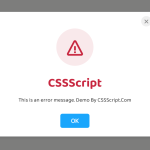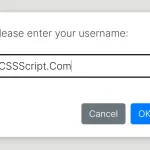| Author: | cbolson |
|---|---|
| Views Total: | 37 views |
| Official Page: | Go to website |
| Last Update: | December 16, 2024 |
| License: | MIT |
Preview:

Description:
A stylish and animated modal window built with the <dialog> element, CSS @starting-style property, and a little bit of JavaScript.
Features:
- Native browser support through the
<dialog>element - Smooth fade-in and translation animations
- Responsive design with flexible styling options
Use Cases:
- Interactive Forms: Collect user input or feedback within a contained, non-intrusive dialog.
- Alerts and Notifications: Display information or warnings in a way that feels polished and modern.
- Lightbox Effects: Showcase media or additional content in a focused modal layout.
How to use it:
1. Add your content within the <dialog> tag:
<dialog id="myDialog"> ... Any Modal Content Here ... <button id="btn-dialog-close" class="btn-dialog-close">✕</button> </dialog>
2. Apply CSS animations and styling to the <dialog>. The CSS @starting-style property defines the initial state of the dialog, setting its opacity to 0 and translating it off-screen. When the dialog opens, the CSS transitions smoothly fade it in and translate it to its final position. The backdrop styling adds a blur effect and transitions its opacity.
dialog{
opacity: 1;
translate: 0;
color: var(--clr-txt);
border: 1px solid rgba(from var(--clr-primary) r g b /.25);
background-color: var(--clr-bg);
border-radius: 10px;
max-width: 270px;
padding: 1rem;
text-wrap: balance;
@starting-style {
opacity: 0;
translate: 0 100svh;
}
transition: opacity 500ms ease-in, translate 500ms cubic-bezier(0.28, -0.55, 0.27, 1.55);
}
dialog[open]::backdrop {
background-color: rgba(from var(--clr-secondary) r g b / .5);
backdrop-filter: blur(3px);
opacity: 1;
@starting-style {
opacity: 0;
}
transition: opacity 1000ms ease-in; /* this doesn't appear to be working */
}
dialog .btn-dialog-close{
position: absolute;
top: 4px;
right: 4px;
border-radius: 50%;
background-color: transparent;
color: white;
border: none;
outline: none;
cursor: pointer;
transition: rotate 300ms, background-color 300ms ease-in-out;;
}
dialog .btn-dialog-close:focus-visible,
dialog .btn-dialog-close:hover{
rotate: 90deg;
}
.btn-dialog-open{
width: fit-content;
margin-inline: auto;
cursor: pointer;
background-color: rgba(from var(--clr-secondary) r g b / .5);
border: 1px solid var(--clr-secondary);
border-radius: 5px;
outline: none;
padding: 1rem 2rem;
font-size: 2rem;
color: var(--clr-primary);
transition: background-color 300ms ease-in-out;
}
.btn-dialog-open:focus-visible,
.btn-dialog-open:hover{
background-color: var(--clr-secondary);
}3. Create a button to trigger the modal:
<button id="btn-dialog-open" type="button" class="btn-dialog-open">Open Dialog</button>
4. Enable the modal’s open and close functionality using JavaScript:
const dialog = document.getElementById('myDialog');
document.getElementById('btn-dialog-open').addEventListener('click', () => dialog.showModal());
document.getElementById('btn-dialog-close').addEventListener('click', () => dialog.close());









